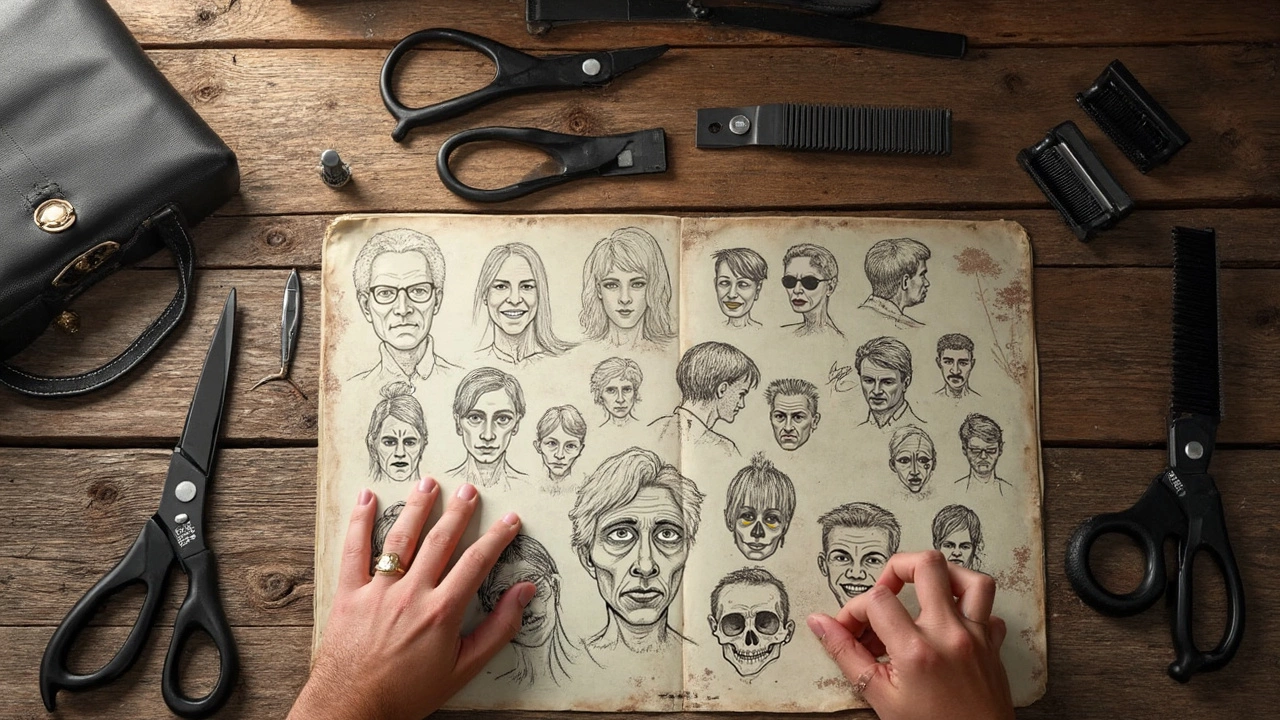Ever thought about cutting hair and wondered, 'How hard can it really be?' Well, it’s like walking a tightrope between art and science. The good news? It's totally doable with the right guidance and practice.
First things first, understanding different hair types is key. Curly, straight, thick, thin—each type reacts differently to cuts and styles, so acknowledging these differences can set you on the right path. It's like getting to know the quirks of your dog, Charlie, before teaching him new tricks.
- Understanding Hair Types
- Tools of the Trade
- Basic Techniques to Get You Started
- Common Mistakes and How to Avoid Them
- Taking Your Skills to the Next Level
Understanding Hair Types
Want to dive into haircutting but unsure where to start? One of the first hurdles is getting a grip on different hair types. It's super important, as knowing what you're working with helps you cut better and style more effectively. This is like knowing the best path to walk Charlie without getting tangled in his leash!
Hair comes in a variety of types, each requiring its own approach. Straight hair, for instance, often needs precision in cutting techniques since any unevenness is noticeable. With curly hair, you'd be dealing with volume and bounce, so the angles and sections you cut need special care to maintain those lively curls.
Here's a quick glimpse into different hair types and their key characteristics:
- Straight Hair: Usually shiny due to the way the cuticles lay flat. It's prone to oiliness as natural oils can travel quickly down the shaft.
- Wavy Hair: Falls somewhere between straight and curly. It can add volume without the curls tightening the look.
- Curly Hair: Forms distinct curls and is more prone to frizz. Each curl behaves differently, so precision is crucial.
- Coily Hair: Tightly coiled and often very dry because the oils can't travel down the hair shaft as easily.
Handling these hair types means not just a pair of shears; you're also choosing the right hairdressing courses to teach you how to adapt your techniques. Some academies even use data to help learners understand which tools work best for each type, and the experiences of those before you can be eye-opening.
| Hair Type | Common Challenges |
|---|---|
| Straight | Oiliness, visible cutting errors |
| Wavy | Balancing volume, managing frizz |
| Curly | Uneven curl patterns, frizz |
| Coily | Dryness, breakage |
Remember, mastering these subtleties can greatly enhance your ability to learn haircutting effectively and prepare you for tackling a variety of styles and clients!
Tools of the Trade
Diving into the world of haircutting, the first thing to wrap your head around is the essential tools. Without the right gear, cutting hair can quickly turn into a frustrating endeavor.
Here's what you'll need in your hairdressing toolkit:
- Scissors: Not just any scissors, but professional shears. They come in different sizes, and finding a pair that feels comfortable and is easy to maneuver is crucial.
- Clippers: For those snazzy fades and buzz cuts, clippers are your go-to tool. They come with various guard lengths to help you achieve different styles.
- Combs: Different combs serve different purposes. A wide-tooth comb is great for detangling, while a fine-tooth comb works wonders for precision cutting.
- Spray Bottle: Keeping hair damp makes cutting easier, so a spray bottle filled with water is a staple.
- Apron or Cape: Keeping clothes clean while cutting is non-negotiable. An apron for yourself and a cape for your client work beautifully.
Investing in quality tools is like having a sturdy leash for Charlie—just makes life so much easier. And remember, keeping your tools clean and well-maintained will extend their life and ensure the best results.
If you're interested in hairdressing courses, many programs offer beginner kits complete with shears, combs, and clippers. It's a great way to start without the headache of figuring out what to buy.
Ready to get started? Equip yourself with these tools, and you're set to take on the world of haircuts with style and confidence!

Basic Techniques to Get You Started
Getting your hands on hair cutting can be exciting and a bit nerve-wracking. But hey, everyone starts somewhere! Let’s dive into some basic techniques that'll give you a solid start in the world of hairdressing.
First up, familiarize yourself with the tools of the trade. The right scissors are like a painter's brush—essential to executing your vision. You'll want a good pair of cutting scissors, thinning shears, a comb, and maybe some clippers if you're feeling adventurous.
One of the most popular beginner techniques is the 'straight cut.' It's exactly what it sounds like and is ideal for removing split ends or trimming lengths evenly. Here's how you do it:
- Section It Out: Always divide the hair into manageable sections to avoid missing spots.
- Comb It Straight: Use your comb to ensure the hair is as straight and tangle-free as possible.
- Snip with Confidence: Be brave. Hold the scissors vertically and make small, controlled cuts.
Now, let's touch on layering, a slightly advanced technique that adds volume and style. Begin by deciding the length of the shortest layer and cutting upwards. It's less intimidating than it sounds and once you get the hang of it, it can do wonders for adding depth and movement.
A common mistake when trying these is cutting too much too soon. It's better to go slow and steady, trimming in increments rather than all at once. Remember, you can always take more off, but sticking it back on isn’t really an option!
By practicing regularly and observing the outcomes, you'll naturally improve. When I first started learning, every little success boosted my confidence big time. It’s kind of like teaching tricks to my dog, Charlie—patience and persistence pay off!
Common Mistakes and How to Avoid Them
Learning to cut hair can seem daunting, especially with so many common pitfalls waiting for newbies. But hey, mistakes are part of the learning curve. Let’s chat about the usual blunders and how you can dodge them like a pro.
First up, using the wrong tools for the job. Whether you're dabbling in hairdressing courses or just trying things out at home, ensure you’re wielding the right gear. Invest in a good pair of scissors specifically designed for haircutting—they make a world of difference.
- Use hairdressing courses to get familiar with scissors, trimmers, and combs.
- Don't improvise with kitchen scissors or other household tools. They're not designed for the job and can lead to jagged ends or uneven cuts.
Another common mistake is cutting too much off at once. Start slow! Take off a little, and then assess. It's like trimming Charlie's fur; better to start small than end up with an unhappy pooch.
"The key to a good haircut is taking your time and making small, precise cuts," says renowned stylist Marco Dupré. "Rushing almost always leads to uneven results."
Next, ignoring hair type differences can be problematic. For example, curly hair shrinks when dry, so cutting it while wet without accounting for this might result in a way shorter look than intended. Know your friend’s or client’s hair type intimately prior to making drastic snips.
Let's talk about a crucial one—uneven layering. Hands up if you've ever tried a trendy layer cut, only for it to seem like a sticker stuck onto the back of your head. Precision matters, so follow these steps for a smooth experience:
- Section the hair properly; use clips to keep things neat.
- Always cut while the hair is wet for easier control, except for specific styles that require dry cuts.
- Check the length consistently across different segments.
By being aware of these common errors and approaching each cut with some basic know-how from hairdressing courses, you're on your way to nailing it like a seasoned pro.

Taking Your Skills to the Next Level
Alright, so you’ve got the basics down pat, and you're feeling confident about cutting your own hair—or maybe even your friend's. What's the next step? Elevating your skills to professional levels opens up a whole new world of possibilities.
Start considering the specialized techniques used by professional stylists. Techniques like layering, texturizing, and blending are key when you're aiming for more sophisticated styles. Each technique has a different impact on the hair's appearance and movement, so experimenting with these can really upgrade your game.
Investing in advanced tools can also make a significant difference. A good pair of thinning shears, high-quality clippers, and various styling razors can help achieve that salon-level finish. It might seem like a big step but think of it as an investment in your future skills.
Attending a hairdressing course is a brilliant way to build on what you’ve learned so far. Not only will you refine your existing skills, but you'll also learn the industry standards and latest trends. Keep an eye out for workshops that offer hands-on experience, as they're invaluable for seeing pro techniques up close.
Here's a nugget of wisdom: consistency is key. Regular practice helps reinforce what you learn, so don’t shy away from these opportunities. Consider setting up a side hustle where you offer services to friends and family. In no time, you'll find your skills and confidence blooming.
Lastly, step into the world of social media. Platforms like Instagram and TikTok are treasure troves of tutorials and inspiring hair transformations. By following experienced stylists, you can pick up new trends and techniques that can further hone your hair styling tips.
With dedication and the right resources, your journey from beginner to advanced won't just be about cutting hair—it'll be about transforming lives, including your own.





Write a comment